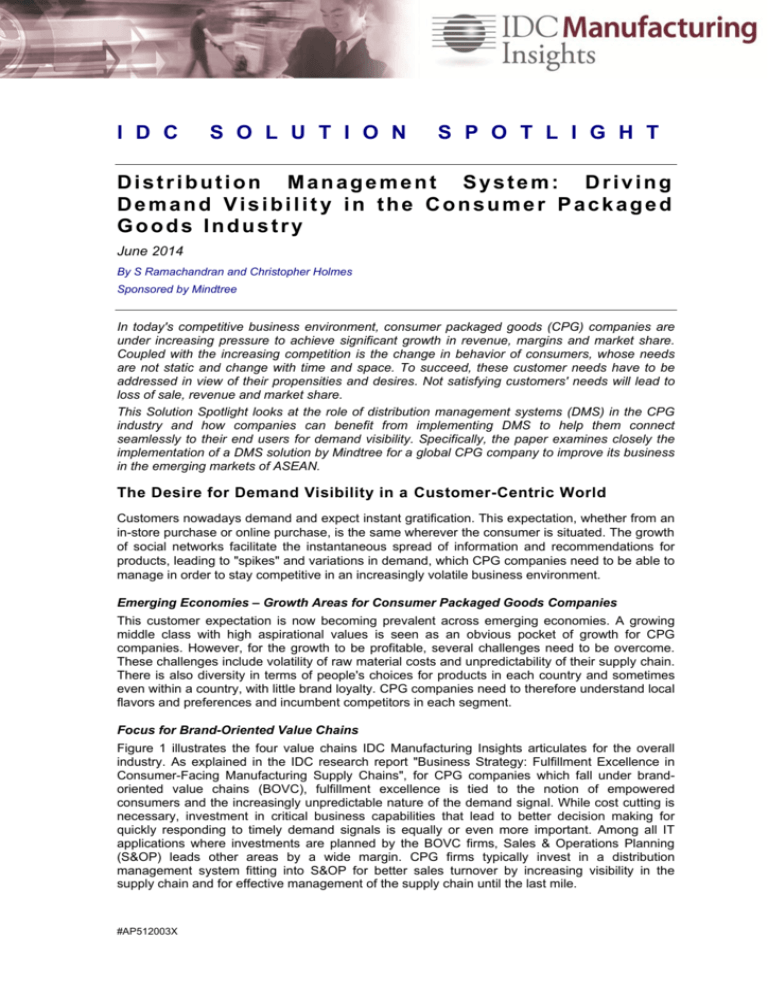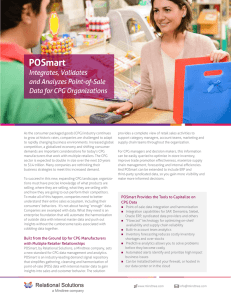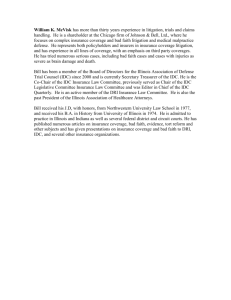
I D C
S O L U T I O N
S P O T L I G H T
Distribution Management System: Driving
Demand Visibility in the Consumer Packaged
Goods Industry
June 2014
By S Ramachandran and Christopher Holmes
Sponsored by Mindtree
In today's competitive business environment, consumer packaged goods (CPG) companies are
under increasing pressure to achieve significant growth in revenue, margins and market share.
Coupled with the increasing competition is the change in behavior of consumers, whose needs
are not static and change with time and space. To succeed, these customer needs have to be
addressed in view of their propensities and desires. Not satisfying customers' needs will lead to
loss of sale, revenue and market share.
This Solution Spotlight looks at the role of distribution management systems (DMS) in the CPG
industry and how companies can benefit from implementing DMS to help them connect
seamlessly to their end users for demand visibility. Specifically, the paper examines closely the
implementation of a DMS solution by Mindtree for a global CPG company to improve its business
in the emerging markets of ASEAN.
The Desire for Demand Visibility in a Customer-Centric World
Customers nowadays demand and expect instant gratification. This expectation, whether from an
in-store purchase or online purchase, is the same wherever the consumer is situated. The growth
of social networks facilitate the instantaneous spread of information and recommendations for
products, leading to "spikes" and variations in demand, which CPG companies need to be able to
manage in order to stay competitive in an increasingly volatile business environment.
Emerging Economies – Growth Areas for Consumer Packaged Goods Companies
This customer expectation is now becoming prevalent across emerging economies. A growing
middle class with high aspirational values is seen as an obvious pocket of growth for CPG
companies. However, for the growth to be profitable, several challenges need to be overcome.
These challenges include volatility of raw material costs and unpredictability of their supply chain.
There is also diversity in terms of people's choices for products in each country and sometimes
even within a country, with little brand loyalty. CPG companies need to therefore understand local
flavors and preferences and incumbent competitors in each segment.
Focus for Brand-Oriented Value Chains
Figure 1 illustrates the four value chains IDC Manufacturing Insights articulates for the overall
industry. As explained in the IDC research report "Business Strategy: Fulfillment Excellence in
Consumer-Facing Manufacturing Supply Chains", for CPG companies which fall under brandoriented value chains (BOVC), fulfillment excellence is tied to the notion of empowered
consumers and the increasingly unpredictable nature of the demand signal. While cost cutting is
necessary, investment in critical business capabilities that lead to better decision making for
quickly responding to timely demand signals is equally or even more important. Among all IT
applications where investments are planned by the BOVC firms, Sales & Operations Planning
(S&OP) leads other areas by a wide margin. CPG firms typically invest in a distribution
management system fitting into S&OP for better sales turnover by increasing visibility in the
supply chain and for effective management of the supply chain until the last mile.
#AP512003X
Figure 1
Value Chain Focus and BOVC
High
Supply
complexity
Low
Engineering-Oriented Value Chains
(Automotive, A&D) ‒ Extensive use of
PLM and front-end design
collaboration. Goal to drive reuse
Technology-Oriented Value Chains
(Electronics) ‒ Use of collaboration to
create visibility and link early demand
feedback to supply/product
requirements changes. Goal to
accelerate time to volume
Asset-Oriented Value Chains
(Oil and gas, chemicals) ‒ Use of
supply chain execution tools for
simple visibility and transportation
management. Goal to maximize ROA
Brand-Oriented Value Chains
(CPG) ‒ Use of advanced S&OP
tools to adjust operational response
to early demand signals. Goal to
calibrate quickly to demand
Low
High
Demand
complexity
Source: IDC Manufacturing Insights
Role of Distribution Management Systems in the Consumer Packaged
Goods Industry
Distribution management systems help in conveying the pulse of the consumers and their touch
points from across the field to a company's headquarters and planning teams to effectively plan
and implement the supply chain. DMS comprehensively manages up to the last mile in the
distribution of products from the factory to the end users. It is deployed by multi-echelon supply
chain organizations which require planning and control of the delivery of their products with
various players involved until the end consumer.
Case Study: Implementation of Distribution Management System for a
Global Consumer Packaged Goods Company
Mindtree's client, a large multinational consumer goods manufacturer, approached their CPG
team for a DMS implementation project. The scope was to implement for exclusive distributors
who sold only the CPG company's products. The program was aimed primarily at the developing
economy – countries in Asia/Pacific divided into seven clusters. Thailand with approximately 50
distributors was selected for piloting. The plan was to pilot the solution for one distributor first,
observe the results and implement for a few more distributors before extending to the entire
country and eventually to the region. The following sections talk about the project implemented by
Mindtree, the details of the implementation, challenges faced and the lessons learnt.
Business Needs
Mindtree's client was looking at improving its business in the ASEAN region, specifically in the
Philippines, Thailand, Vietnam and Indonesia. While cities within these countries are developed,
the business environment changes very rapidly as one moves away from the main hubs – there is
less infrastructure, leading to challenges across the supply chain. The company's products
include a wide range from food and beverage to personal care and home care products. Products
reach the consumers through a diverse network of distributors, wholesalers, retailers and outlets.
In order to operate efficiently, an application to effectively manage the entire distribution process
was required.
Specifically, the high level business objectives are as follows:
Increase sales turnover by 7–9%
Exceed the already planned country growth
Tighter control over promotions, pricing
Improved management of sales targets
Improved accuracy in product master data
A single sales platform, providing a collaboration platform for field sales with
recommendations, control and higher visibility on the secondary sales data
Visibility across the entire supply chain, including remote areas
2
©2014 IDC
SAP was available as the core ERP at the start of the project. But the modules required for
distribution management and enabling of mobility were not implemented. There was no process
rationalization across countries in the ASEAN region. Each country had its own policies and a
standardization of process was required before implementing any automation.
Partner Selection Criteria
SAP was already selected as the core platform. The next step was to shortlist vendors from the
original six that participated in the RFP (request for proposal) process for a systems integrator. At
this stage, a detailed proposal had to be presented. The criteria for the implementation partner
selection included the solution methodology, credentials from prior clients, technology exposure,
domain knowledge and cost of implementation. Mindtree had prior experience in emerging
regions for DMS implementation. Utilizing this experience allowed Mindtree to look at expanding
into distribution management in different industries, geographies and segments. This type of a
project was new since it was an implementation across several countries with diverse business
processes, languages and cultures.
Project Targets
The following are the benefits that were targeted by means of the DMS implementation at the
start of the project, translated from the high level business benefits:
Effective order fulfillment process – 98% achievement in case fills
High field presence – 97% of bills through mobility/field
Greater turnover driven by improved product availability, promotion compliance, perfect store
execution and higher drive for article assortment
Sales force automation – faster sales execution and efficiency with effective device usability,
remote outlet tracking which in turn contributed to higher number of calls, price visibility
30% increase in lines per productive call and targets for lines in each call met
A robust base framework, with standardized processes now available for mass roll-out and
targeted countries in roadmap
Implementation of the Project
Thailand was selected for piloting the DMS platform with an eight to nine-month project timeline,
beginning with just one distributor and then rolling out to other distributors. This pilot is now
complete and the coverage of remaining distributors in Thailand is in progress. Improvement
metrics post-implementation are being gathered. The following sections detail the various aspects
of the project implementation, as depicted in Figure 2 below.
Figure 2
Multiple Tracks and Release Planning
DMS
Release planning
SAP IS Retail
Functional
Functional
Definition
Definition
Functional
Functional
Definition
Definition
Integrations
Mobility
Piloting Detailed roll-out
Piloting Detailed roll-out
Thailand
Piloting Detailed roll-out
Piloting Detailed roll-out
Vietnam
Program Management (PMO)
Change Management (Steering
Committee)
Country Management
Continuous Improvement Program
Source: IDC Manufacturing Insights, 2014
©2014 IDC
3
CPG company
CoE
SAP-IS Retail Implementation
The Retail Information System (RIS) enables goods movements to be planned, monitored and
tracked throughout the whole supply chain. Key modules implemented include master data,
materials management, sales and distribution, finance, promotions management and business
intelligence (BI) reports.
Prior to implementation, the CPG company's IT team and Mindtree consultants conducted an
eight-week process harmonization workshop with representatives from all countries. In the
workshop, business processes of all countries were discussed and evaluated to arrive at a
common set of processes. This process harmonization then led to a core platform which would be
implemented across all countries. The core platform constitutes approximately 80% of the overall
solution, with the remaining being country-specific implementation.
The key challenge was to harmonize different business processes across countries. This was
achieved through detailed business process workshops involving representatives from all the
countries and elaborate business blueprinting phase. System performance was foreseen to be a
critical issue and the project team took initiatives proactively to replicate the expected system load
and perform rigorous performance testing. The findings of the testing were then utilized to derive
optimal system sizing and performance tuning.
SAP IS Retail platform for DMS was real-time integrated with software as a service (SaaS)
mobility platform. For reduced infrastructure costs, a private secure cloud was set up in
collaboration with the cloud partner. The mobility platform supported Android and Windows
mobile devices and provided real-time location tracking, stock visibility and orders status. Data
analytics was provided as part of the platform. It was predominantly implemented to provide
recommendations on van stock load based on historical sales. Figure 3 shows the overall
architecture implemented and the various modules that integrate with each other – core ERP
which is SAP and retail, mobility and business intelligence modules on top of it.
Change management was a serious challenge. This was managed with support from the
business team and Mindtree. The distributors to whom the DMS system was to be rolled out to
were involved from the beginning all through the implementation cycle. This resulted in
acceptance of the solution.
Around 70–80% of the implementation is the same across countries. But due to local regulations,
statutory requirements, language and currency requirements, 20–30% of local customization
needs to be done for each country.
Mobility Implementation
The business need behind the mobility implementation was to empower the sales team on the
field with data intelligence, for example, to suggest stock keeping unit (SKU) level order quantities
for a retail outlet, execute promotions, new product launches, shelf availability at the distributor
end and diversification, and for flow back of order placement, feedback from the field/competitors,
and eventually for seamless collaboration between field and backend teams.
The following performance metrics were defined to measure the impact of the mobility
implementation:
CCFOT (customer cases filled on time) – opportunity to improve on-time, first-time-right order
fulfillment of customer orders from 90% levels
Bill throughput – opportunity to increase lines per order from approximately 10 per order to
higher levels on each productive call. A productive call is one in which a salesperson's visit to
a retailer results in a successful order
Sales value – growth in month-over-month sales value over and beyond the levels noticed
before mobility implementation
Assortments – choosing the right mix of related products
4
©2014 IDC
The mobility application is integrated with SAP IS Retail. The mobility product is a standard
product with basic modules and 70% of out-of-the box functionality. 30% of customization for
country specific requirements is implemented.
Figure 3
ERP and Mobility Architecture Implemented
Customer
Mobility
Client
Mobility
Client
Mobility
Client
SAP ERP
Central DB
Central Web
Service
SFTP
SAP PI
GPRS
Mobility
Foundation
Firewall
GPRS
DMS PI
SAP ERP
IS RETAIL
SAP BW
Sales Rep
Survey client
Sales Rep
Survey client
Sales Rep
Survey client
Source: Mindtree CPG Team
Software Lifecycle Development Cycle/Project Management Methodology Used
Mindtree used SAP's ASAP methodology (Accelerated SAP) which consists of five phases in a
waterfall model. SAP IS Retail and mobility are two key tracks where implementation happens,
including integrations between them and with other applications such as core SAP. Functional
definition, the entire development cycle starting from design to development, testing and roll-out,
considered under piloting and eventual roll-out are three major islands of activities. Program
management to ensure project milestones, timelines, cost and effort, continuous improvement to
remove inefficiencies in the software lifecycle development cycle (SDLC) process, change
management and country-level specifics are other tracks that happen in parallel.
Overcoming Challenges
The DMS implementation was not without challenges. These include:
Country-specific configurations along with global configurations. This challenge could not be
overcome completely. Around 80% of the business logic was common across countries;
however, the rest had to be configured specific to each country based on factors such as
currency, exchange rates, regulations, market specific promotions and the legal system.
Handling data intelligence load on light weight devices during multi-distributor onboarding.
Concurrent synchronization of the diverse device portfolio of salesmen. The mobile
applications have to be compliant with each of the device/OS combinations in the field with a
plan in place to percolate any changes and updates to the applications across the user base.
Change Management
Scope creep was a challenge and to address this, a team was set up to ensure standardized
processes were used across countries. Once this team approved a change, a Change
Management Board consisting of wider stakeholders looked at other perspectives such as cost
and timelines and approved it. Once approved, a formal change request was raised to start
impact analysis, design, implementation and testing.
©2014 IDC
5
Project Team Ramp-Up
SAP provided partnership for the first three to four months to start implementation. Mindtree
started with a skeletal team and gradually ramped up to include a fully functional PMO (project
management office) along with implementation and testing teams. At the end of 18 months,
Mindtree was managing implementation independently. In terms of end user training, Mindtree
provided training in English while the business took care of local languages.
Looking Ahead: Lessons Learnt from the Pilot
Mindtree has rolled out the pilot for a few distributors in Thailand. The benefits are being
measured and analyzed at the time of this case study. Based on successful validation, the
solution will be gradually customized and rolled out across Thailand and more countries. The
lessons learnt from implementation across one country are immense and can be leveraged for
the next country. Learning points range from change management at the people level,
understanding business processes and field level activities to technology related lessons learnt.
These areas for improvement are relayed by the project team to the PMO for the next roll-out.
Process Standardization
Rolling out the solution for one country presented a set of unique challenges around adoption of
technology and the new process. As the implementation scales up, different types of challenges
can be anticipated. Approximately 20% of local requirements were customized out of the global
solution. Hence, the ripple effect of changes in one country across previously rolled out countries
can grow exponentially. Change management would become difficult to handle. The amount of
effort put in for training of teams whenever there is a change, quality efforts for regression testing
and management of the list of changes is an area the project team should be prepared to handle.
Moving Up the Maturity Curve
For moving up the maturity curve in the SAP and mobility implementation, it is recommended that
Mindtree use a benchmarking model to assess the current level of maturity and to fix a target in
that model that is challenging, feasible, well defined and time bound. Knowledge management
can be used to document best practices and lessons learnt to work toward gradual reduction of
effort after every roll-out. There should be a declining trend of overall effort for implementation
and roll-out going forward. Continuous improvement projects should be motivated to find and
eradicate inefficiencies in the business and IT processes. Reusability of business processes,
applications, codes and documents should also be encouraged and recognized.
Conclusion
IT platforms such as DMS coupled with mobility for last mile connectivity provide CPG firms with
an opportunity to leverage them, improve supply chain visibility and thereby have a positive
impact on the top line and bottom line. Enterprises which identify this opportunity early and
implement it the right way would have a significant advantage. The implementation should include
long-term visibility for it to fit into the business model and processes including the IT landscape
with well-designed architecture for scalability, maintainability and seamless integration with other
applications in the enterprise.
A B O U T
T H I S
P U B L I C A T I O N
This publication was produced by Manufacturing Insights Go-to-Market Services. Manufacturing Insights Go-to-Market
Services makes Manufacturing Insights content available in a wide range of formats for distribution by various companies.
A license to distribute Manufacturing Insights content does not imply endorsement of or opinion about the licensee.
C O P Y R I G H T
A N D
R E S T R I C T I O N S
Any Manufacturing Insights, and IDC Company, information or reference to Manufacturing Insights that is to be used in
advertising, press releases, or promotional materials requires prior written approval from Manufacturing Insights. For
permission requests contact the GMS information line at +65-6829-7757 or gmsap@idc.com. Translation and/or
localization of this document requires an additional license from Manufacturing Insights.
For more information on IDC visit www.idc.com. For more information on IDC GMS visit www.idc.com/gms.
IDC Asia/Pacific, 80 Anson Road, #38-00, Singapore 079970
P.65.6226.0330
F.65.6220.6116
www.idc-mi.com
Copyright 2014 IDC. Reproduction is forbidden unless authorized. All rights reserved.
6
©2014 IDC









